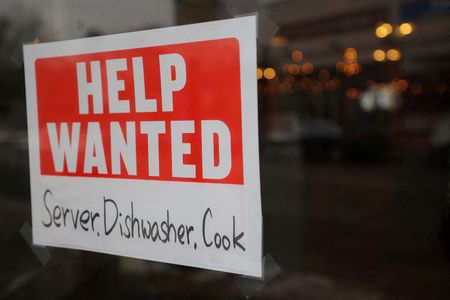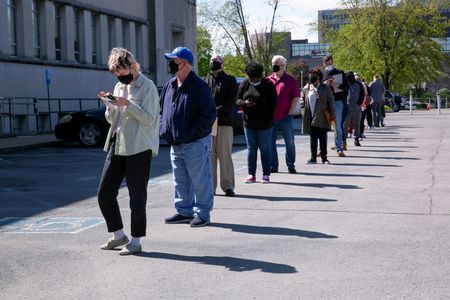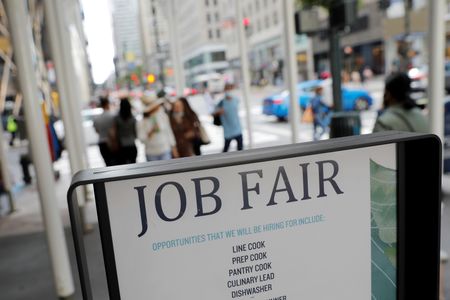


By Lucia Mutikani
WASHINGTON (Reuters) – The number of Americans filing new claims for unemployment benefits increased more than expected last week, further evidence that labor market conditions were gradually easing as higher borrowing costs dampen demand in the economy.
The slowing momentum in the economy was underscored by other data from the Labor Department on Thursday showing producer prices falling by the most in nearly three years in March, with sticky services inflation subsiding. Still, the labor market and inflation are likely not cooling fast enough to stop the Federal Reserve from raising interest rates one more time next month.
“Fed officials couldn’t ask for better data today as the economy looks like it is running out of gas finally after a year of rate hikes,” said Christopher Rupkey, chief economist at FWDBONDS in New York. “Fed officials thought the economy might slow after the banking crisis and now it appears that the slowdown is happening.”
Initial claims for state unemployment benefits rose 11,000 to a seasonally adjusted 239,000 for the week ended April 8. Economists polled by Reuters had forecast 232,000 claims for the latest week.
Unadjusted claims increased 27,457 to 234,577 last week, with filings in California surging 11,388. There were also significant gains in claims in New Jersey, Pennsylvania, Texas, New York and Connecticut. That offset a notable decline in Ohio.
Annual revisions to the data published by the government last week showed claims were much higher this year than had been previously estimated, aligning with a rush of high-profile layoffs in the technology industries as well as other sectors highly sensitive to interest rates.
Claims, however, remain below the 270,000 level, a breach of which economists say would signal a deterioration in the labor market. Last Friday’s employment report showed a slower but still-solid pace of job growth in March.
Job openings fell below 10 million at the end of February for the first time in nearly two years. Nevertheless, there were 1.7 vacancies for every unemployed person that month, which could make it easier for some laid-off workers to land a job.
The claims report showed the number of people receiving benefits after an initial week of aid, a proxy for hiring, dropped 13,000 to 1.810 million during the week ending April 1, not too far from pre-pandemic record low levels.
There are no signs yet that a tightening in credit conditions following the failure of two regional banks last month has led to job losses.
Economists expect small businesses like restaurants, bars and nail salons would be affected by a credit crunch.
“We expect the health of the labor market to deteriorate at a gradual pace in the second quarter but then weaken more quickly in the second half as the economy suffers a mild recession,” said Oren Klachkin, lead U.S. economist at Oxford Economics in New York. “The upcoming labor market downturn will be modest since the drop in demand is expected to be fairly modest.”
Stocks on Wall Street were trading higher. The dollar fell against a basket of currencies. U.S. Treasury yields were mixed.
GRAPHIC: Jobless claims https://www.reuters.com/graphics/USA-STOCKS/gdpzqnnzavw/joblessclaims.png
SERVICES PRICES FALL
Financial markets are betting that the Fed will increase rates by another 25 basis points at its May 2-3 policy meeting, according to CME Group’s FedWatch tool. That will likely be the last rate hike in the U.S. central bank’s fastest monetary policy tightening campaign since the late 1980s.
The Fed last month raised its benchmark overnight interest rate by a quarter of a percentage point, but indicated it was on the verge of halting further rate increases in a nod to the financial market turmoil. It has hiked its policy rate by 475 basis points since last March from the near-zero level to the current 4.75%-5.00% range.
In a separate report on Thursday, the Labor Department said its producer price index for final demand dropped 0.5% in March, the most since April 2020, after being unchanged in February.
A 1.0% decline in goods prices accounted for two-thirds of the decrease in the PPI. Goods prices fell 0.3% in February. Gasoline prices plunged 11.7% last month, while food prices rebounded 0.6%. There were also decreases in prices for diesel fuel, residential natural gas jet fuel and electric power.
Gasoline prices are set to rebound after Saudi Arabia and other OPEC+ oil producers early this month announced further oil output cuts. Excluding the volatile food and energy components, core goods prices rose 0.3%, matching February’s gain.
Prices for services fell 0.3%, the largest decline since April 2020. There was a 0.9% drop in margins for trade services. The cost of transportation and warehousing services fell 1.3%.
In the 12 months through March, the PPI increased 2.7%. That was the smallest year-on-year rise since January 2021 and followed a 4.9% advance in February.
GRAPHIC: Inflation https://www.reuters.com/graphics/USA-STOCKS/zgvobjjqdpd/inflation.png
The annual PPI rate is subsiding as last year’s large increases drop out of the calculation. Global supply chains have improved significantly. Economists had forecast the PPI would be unchanged on the month and climb 3.0% on a year-on-year basis.
The government reported on Wednesday that overall consumer prices barely rose in March.
Excluding food, energy and trade services components, producer prices gained 0.1% in March. The core PPI climbed 0.2% in February. In the 12 months through March, the core PPI advanced 3.6% after increasing 4.5% in February.
With the PPI and CPI data in hand, economists estimated that the core personal consumption expenditures (PCE) price index increased 0.3% in March, matching February’s rise. The core PCE price index was forecast to advance 4.6% on a year-on-year basis after a similar increase in February.
The core PCE price index is one the inflation measures tracked by the Fed for monetary policy. March’s data will be published at the end of this month.
“For a Fed already inclined to pause, this report tips the scale just a bit more in favor, especially after yesterday’s CPI failed to reveal any new inflationary problems,” said Chris Low, chief economist at FHN Financial in New York.
(Reporting by Lucia Mutikani; Editing by Chizu Nomiyama, Andrea Ricci and Paul Simao)

